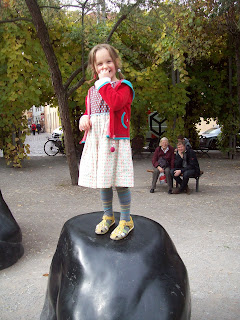Well, anyway that’s what Gretchen has done. “Let’s Get Together,” enjoin the most famous twins in American history at the Museum’s Hallow Eve Party, Friday, October 31, 1986. The Mütter connection is that they were autopsied by the College of Physicians of Philadelphia in 1874, and their joint liver (which made it impossible for them to be separated surgically while they were alive) now floats amiably in the Mütter’s collection.
Ghoulishly, the Mütter is reopening on a ghostly night,
displaying what the same Boston graphics firm that did up “Miracle at
Philadelphia” for the Bi-Cen of the Constitution has done to perk up their
holdings. Chang and Eng, who came as together as it’s possible to be, were born
in 1811 in Maklong, a small fishing village 60 miles from Bangkok in what was
then called Siam (Thailand). In 1824, the British merchant Robert Hunter first
saw them and eventually arranged to have them shipped to Boston on Captain Abel
Coffin’s ship “Sachem.” He first “showed” them in London, but they decided to
exhibit themselves when they got back to America in 1832. They became the
centerpiece of P.T. Barnum’s Museum of Oddities in New York City, and toured
the country with him during the mid-1830’s.
In 1839, they “retired” to become shopkeepers in Wilkesboro,
North Carolina, and later farmers in nearby Trap Hill. On April 13, 1843, Chang
married Adelaide Yates and Eng married her sister Sarah. They took the surname
Bunker, after a friend. The Civil War wiped them out financially so they took to
the road again, touring for a season in Europe with Major Henry London and then
again with Barnum. In 1870, they returned to America where Chang had a
paralytic stroke that affected one side. On January 17, 1874, Chang succumbed
to a cerebral clot, and Eng died a few hours later, some think from fright.
(Heh, this is a Halloween story!)
What a strange life. The band which joined them, which
extended from the junction of the abdominal and thoracic cavities, grew in
elasticity as they grew, so they were able to stand side by side and even back
to back. Thus physically this allowed much freedom to do many sports and engage
in farm work. But alas it did not permit them to avoid each other’s blows in
their frequent quarrels. Chang was irascible and a heavy drinker, while Eng was
good-natured and not a heavy drinker. (Oddly, Eng never felt the effects of
Chang’s mean hangovers!)
They lived on two farms about a mile and a half apart,
three days at each place alternately. When they died, the local physicians kept
the bodies in good condition for two weeks by burying them in a coffin encased
in tin in Eng’s cellar under a layer of powdered charcoal—waiting for the
Philly physicians (Drs. William H. Pancoast and Harrison Allen) to arrive to do
the autopsy. A plaster cast of their torso will enliven your Halloween party,
which is a costume affair. Double daters might pass as a set of Siamese Twins.
You get the idea!
The Mütter is not all ghouls and games, by a long shot. In
1787, twenty-four of the leading physicians of the city banded together to
gather scientific and medical knowledge from America and abroad, to promote the
use of this knowledge for the public welfare, and to encourage the highest
standards of professional practice and conduct among its members and their
colleagues.
In 1858, Dr. Thomas Dent Mütter formally donated his unique
collection to the College, although it was not open to the public until it was
installed in the College’s then new quarters at 13th and Locust. Mütter
had been a popular professor of surgery at Jefferson Medical College from
1841-56, and he gathered this outstanding collection of anatomical and
pathological specimens and models to support his teaching. Upon his retirement
in 1856, he expressed a wish to found a “pathological museum” open to all
physicians and medical students without charge “to serve at once the cause of
science and humanity” and to repay the profession which had been so good to
him.
The College of Physicians remained true to Mütter’s charge
by adding over the years more specimens as well as medical, dental,
pharmacological and nursing instruments that illustrate the evolving history of
health care in Philadelphia. Its reach extends as well to both folk medicine
and quackery. Are you into skeletons? They have a dwarf’s (3’ 6”) and a giant’s
(7’ 6”). Are you into crania? Eggheads of the Delaware Valley unit: they have
139 skulls; assembled by a Viennese physician to show anatomical variations.
Not to forget the tumor removed from President Grover Cleveland’s jaw in 1893
(the operation was secret for reasons of state security).
Cocktails (no formalin used) from 6:30-7:45 p.m. cost $25;
the dinner and dancing (8 p.m. on, Scott Joplin & Friend provide the music)
is $100 per skeleton, $75 tax-deductible. RSVP by October 24, 561-6050 x 42.
(Otherwise free, Tuesdays-Fridays, 10-4.)




